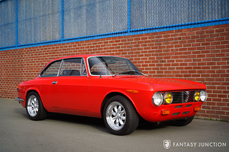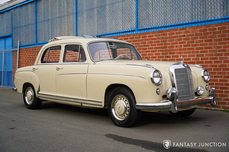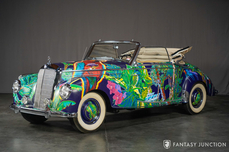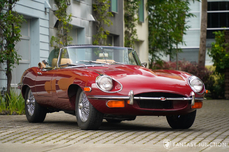Vauxhall 14-6 4.2 Liter Inline-4 no. 3774 1924
Allmän beskrivning :
1924 Vauxhall “14/98” Sports Special
s/n LMM3774, Eng. no. 3774
Dark Green with Red Leather
The earliest examples of Edwardian era sporting cars appeared at a time in automobile development when industry was booming and individual wealth was increasing at historic rates. European royalty, Hollywood film stars, and youthful sons of industrial tycoons favored sports cars of this period for their performance and exciting character. For Vauxhall, one of the first British car companies as well as one of the oldest extant, the legendary Bedfordshire builders delivered handmade cars with world-class engineering, the latest in engine technology, and sporting coachwork during the years before 1925, when they were acquired by General Motors.
While many of the earliest Vauxhalls were expressions of wealth and opulence, often a trinket to adorn a manor or castle, many of their cars also proved durability in racing, trials, and hillclimbs. Today, while their manufacturing prowess in modern scale is recognized as one of the most prolific, it is their early cars from their independent days that truly embody the magic of the marque, imbued by the determination and principled ingenuity of their earliest founders and skilled craftsmen.
Certainly this beautifully-executed example perfectly articulates the exceptional philosophy of Vauxhall’s early days. Crafted under commission by premier Edwardian Era specialist and expert Grant Crowie of Up The Creek Workshop in Cambell’s Creek, Australia, this “14/98” Special was crafted using a 14/40 series chassis accompanied by carefully sourced original Vauxhall components, with the exception of a 1920s era Delage front axle and vacuum servo brakes, used for their added stopping capability. Linton Morris, an Australian Magistrate who specifically commissioned the construction of this Vauxhall for hill climbing, insisted the car have both torque and speed in addition to the Vauxhall durability they were known for. The engine and transmission began as a 23/60 series unit but were thoughtfully upgraded to the more formidable later series 30/98 specifications. Likewise, the engine is of the 30/98 type, utilizing the 4224cc detachable cylinder head design with overhead valves that distinguished the definitive OE version of the 30/98. Originally rated at 115hp with a single carburetor, this engine was upgraded to employ two period correct 2” bronze casting S.U. carburetors and a correct Watford F04 magneto. A 14/40 rear axle with a new high ratio crown gear and pinion was fitted, along with open driveshaft. Rear suspension is via a conversion to semi-elliptical springs as on the 30/98. The build was completed in 2014 after exhaustive testing, fabrication, and exceptional attention to detail and unity of components. The finished car was tested and refined, delighting all who were fortunate to view the car in shows and events in Australia.
The current owner purchased the car later in 2014 and imported it to California, where it was further updated and improved in 2015 and 2017 by experts Bob Mosier (Mosier Restoration, Inc.) and Olle Eriksson (Eriksson Enterprises), both of whom logged extensive hours tuning and sorting the car as well as improving braking performance. Detailed invoices totaling over $11,000.00 further support the ongoing care and maintenance this beautifully constructed Vauxhall has received throughout the current ownership.
Today, this magnificent and sporting Vauxhall presents with exceptional finishes and magnificent presence. Adorned with a delightful array of aircraft-inspired details including the riveted, louvered, and contoured aluminum hood, exposed mechanical details, exquisitely detailed castings, and painstakingly constructed brass hardware, lines and fittings, the result is a symphony of details for the eyes – each one captivating the viewer with authentic finishes and purposeful presence. The body panels are very well fit to the chassis and the paint on the rear portion of the car is glossy and smooth throughout. Every detail has been handled with mastery as witnessed by the beautifully fitted brown leather rear fender covers, which tastefully match the passenger side cowl apron. Throughout the car, Edwardian details are beautifully represented in handles, levers, polished castings, delicate engraving, and perfectly selected hardware. The delicately suspended front fenders float lightly above the wheels, tapering with a slight dihedral toward the cowl, again exemplifying how small details can contribute to the impressive visual impact, the stance, and overall presence.
The interior of the car is finished with red leather covering the pleated seats, smooth side panels, and lining the interior of the cowl. Contrasted by black carpeting with red edging and a polished aluminum dashboard, the purposeful black enameled steering wheel sits proudly over an array of delightful instruments and switches, each one an artful combination of vintage calligraphy and machined castings. The L & M Rye coachbuilder badge is positioned on the dash in keeping with proper vintage construction. The car displays exceptional visual harmony in every respect: its interior and exterior design, details, and presentation all display wonderful unity, a testament to the craftsmanship and integrity of this uniquely constructed Vauxhall Special.
The engine compartment reveals the same level of attention to detail and vintage authenticity in fit, finish, and period correct hardware. Various components are gently polished or remain slightly buffed to underline the car’s vintage. The engine compartment, cowl, and revealed suspension components are all clearly in view and beautifully presented. There is no hiding even the smallest detail, and therefore the simplest of items are instead celebrated with exceptional fit, finish, and authenticity.
The car is not only beautifully constructed, it is a pleasure to drive. It starts easily but also with the marvelous theater associated with cars of this period: master electric power, magneto, fuel pump, spark advance/retard, choke, and hand throttle properly set, the car explodes to life with a textured and explosive aural character that will be familiar to anyone who has spent time around a 3 or 4.5 liter Bentley. The throttle response and carburetion are spot on, and the hand throttle allows the driver to accommodate for the engine as it warms up. The gearchange has a wonderful mechanical character and is of course unsychronized, rewarding the skilled operator with a set of usefully spaced ratios to capitalize on the car’s remarkable torque and light weight. Driving this car is a genuinely swift and thrilling experience. Thanks to the conversion to hydraulic actuation, the effectiveness brakes is positively excellent for a car of this period. Failing that, the Klaxon horn delivers the now iconic sound at the push of a button, simultaneously warning and delighting other road users. The steering is heavy at low speeds, but precise and informative once underway. The overall feel of the car is one of quality and durability. Unlike many cars from this period, it feels solid, well-resolved, and trustworthy: the quality of the craftsmanship that went into the build is evident from the moment the driver touches the first switch.
The underside of the car is very much in keeping with the rest of the car’s presentation, with a sanitary, well-finished and detail-oriented execution. Copious notes detailing proper oiling and various lubrication requirements, engine specifications, starting instructions, diagrams for all instrumentation, notes and invoices for recent service, and import documentation from Australia are included with the car.
Great cars from this exceptional and exciting period are becoming more and more sought after in a world where the driving experience has become dulled down by digital interaction. With so many important cars of this era now residing in museums as immobilized sculpture, this is a great opportunity to acquire a very usable car, one that embodies the thrill of power and performance in a very capable package. This exciting Vauxhall Special delivers not only impressive construction and design coupled with a brilliantly engineered chassis, it offers the next owner a unique opportunity to experience spirited open air driving in an exceptionally pure form. Undoubtedly the one of this type, this Vauxhall attracts positive attention wherever it goes. In that vein, it represents the ultimate event car for the adventurous individualist: the antidote on the California Mille for “just another XK140 or Giulietta,” a car that makes a strong case for acceptance for anyone daring enough to enter it.
http://fantasyjunction.com/cars/2109-Vauxhall-14/98%20Sports%20Special-4.2%20Liter%20Inline-4
1924 Vauxhall 14-6 4.2 Liter Inline-4 no. 3774 is listed såld on ClassicDigest in Emeryville by Fantasy Junction for $149500.
Fakta i bilen
Karosstyp : Personbil Märke : Vauxhall Modell : 14-6 Modellversion : 4.2 Liter Inline-4 no. 3774 Motorvolym : 4.2 Årsmodell : 1924 Läge : Emeryville
Såld
Information om säljaren
Såld
Other cars listed for sale by this dealer
om Vauxhall
Historien om Vauxhall Motors, en brittisk biltillverkare, är en rik väv som sträcker sig över mer än ett sekel som involverar innovation, samarbeten och övergångar.Tidiga år: Vauxhall grundades 1857 i Vauxhall, London, som ursprungligen producerade pumpar och marina motorer. 1903 vågade de sig in i biltillverkning och skapade sin första bil, Vauxhall 6HP. Varumärket fick ett rykte för att producera pålitliga fordon.
Förvärv av General Motors (GM): 1925 förvärvades Vauxhall av General Motors (GM), vilket påverkade dess bana i flera decennier. Detta partnerskap förde tekniska framsteg och utvidgade Vauxhalls marknad.
Äkta Vauxhall -modeller: Under de tidigare åren av Vauxhalls historia, särskilt före samarbetet med Opel, producerade Vauxhall bilar som var unika utvecklade av företaget. Dessa fordon, såsom Vauxhall Victor, Viva och Cresta, designades och konstruerades av Vauxhall oberoende av Opel.
Badge-konstruerade Opels: När Vauxhall kom under ägandet av General Motors (GM) i mitten av 1900-talet blev det en del av ett nätverk av GM-ägda varumärken som inkluderade Opel i Tyskland. Detta ledde till utövandet av Badge Engineering, där vissa Opel -modeller omklassificerades och såldes som Vauxhalls i Storbritannien och vice versa.
Till exempel hade modeller som Vauxhall Carlton och Cavalier sina motsvarigheter i Opel -serien, till exempel Opel Omega och Ascona. Dessa bilar var i huvudsak samma fordon med mindre kosmetiska skillnader och marknadsfördes under olika märken för specifika marknader.
Denna strategi gjorde det möjligt för GM att effektivisera produktions- och utvecklingskostnader genom att dela plattformar och tekniker över marknader och därmed skapa bilar som var ekonomiskt genomförbara för olika regioner samtidigt som man behåller en utmärkelse av distinkt varumärke.
Upplevda skillnader: Medan många av dessa märken-konstruerade modeller delade mycket av deras teknik, komponenter och teknik, fanns det uppfattningar bland vissa konsumenter och kritiker som Opel-badged bilar kan ha varit något mer förfinade eller bättre utrustade jämfört med deras vauxhall-motsvarigheter. Men denna uppfattning var inte universell och kanske inte har varit sant för alla modeller.






